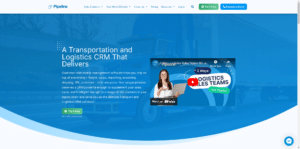Salespeople struggle with a hidden problem.
Closing or prospecting.
When it comes to prospecting, some salespeople are experienced pros. They’re able to fill their sales pipeline with a steady flow of leads. Others excel at closing, but they struggle with prospecting; they’re skilled negotiators, but they need help to fill their sales pipeline.
Why salespeople struggle with closing or prospecting
According to a recent report, 51 percent of salespeople are struggling to generate leads. Research from MarketingSherpa shows as many as 73 percent of your prospects are not ready to buy. These sales leads need to be nurtured and prepared before they’re ready to convert to customers.
This means approximately 27 to 35 percent of the leads generated by marketing are sales-ready.
See the problem?
Closers who receive these sales-ready leads from marketing typically do very well. Prospectors, not so much.
What about follow-up and lead nurturing?
This is where prospectors tend to shine; they’re able to follow up with leads consistently; they communicate in a way that’s appealing and insightful. It’s a rare (and experienced) breed of sales professionals who can do both.
What if you aren’t there yet?
What if you don’t have an intuitive sense of closing, or you don’t have the prospecting skills you need to keep your pipeline full? Are you simply out of luck?
What is a sales pipeline?
Your sales pipeline is a management process.
It’s a visual process that outlines every step of your sales process — from a potential customer’s first interaction with your company to the final closing of the deal.

As prospects take actions that move them forward in the sales process, these are recorded in the sales pipeline. When combined with customer relationship management (CRM), your sales pipeline enables you to visualize and track the progression of all current prospects and deals.
Sales pipelines aren’t created equal.
Each company has a different sales process, and every sales pipeline will have different stages.
The process for a company that produces custom machine parts may start with:
1. Prospecting for potential clients in their industry.
2. Progress through several negotiations of design specifications and finish with…
3. Final approval of the design plan.
What about an ecommerce site? Their sales pipeline will be different:
1. Convert a PPC visitor to an email subscriber or social media follower.
2. Convert email subscribers or social media followers to customers via an incentive or irresistible offer
3. Customers add products to their shopping cart
4. The customer completes the checkout process then clicks “Buy Now.”
The length of your sales cycle and the speed customers move through your pipeline depend on several variables.
· Your business model: Services typically require more vetting time than products. The details of a product generally are set, while offerings in a service are variable. This isn’t always the case, of course, but it applies to most industries. It takes more time to find, vet, and hire an attorney than it does to purchase products like clothing or books.
· Offer pricing: As a general rule, the higher your price, the longer your sales cycle. It takes more time to purchase big ticket items — flooring, real estate, vehicles than it does to buy a smartphone or apps for your smartphone.
· Customer urgency: If your customer has an urgent need, i.e., ordering a replacement part to repair critical machinery, they’ll move through your pipeline faster. The urgency they feel will be intense, especially if they cannot get what they need from other sources.
· Your process: If you invest the upfront time required to disqualify prospects who aren’t a fit, you’ll find your close ratios go up as you shorten your sales cycle. This isn’t all that common; it’s actually more common for sales managers to state that all leads are equal, that they can close the same leads you have, implying that lead quality isn’t important. The quality and quantity of your lead flow is an essential variable.
Prospects who have done a lot of research before contacting your company may also be ready to buy earlier in the process than those who have not. Other prospects may progress through the sales pipeline more slowly, taking time to learn more about your products or services before they’re ready to make a purchase.
This is why you need a sales pipeline.
A sales pipeline gives you the structure you need to bridge the gap between prospecting and closing. With a sales pipeline, you know:
· How to prioritize and segment your attention between prospects and customers
· Which prospects need/deserve your attention now, later, and never
· When to reach out to prospects and how to do it (e.g., renegotiate, close, disqualify, etc.)
· The key details and insights that are essential for closing each sale can be included in your CRM as part of the process
· How to use data from past deals to win future deals
· How to use historical data to qualify and disqualify prospects
· The profile of a high-value customer and dysfunctional customer and the behaviors they exhibit regularly
And the most important reason?
Your sales pipeline helps you to monitor your lead flow. As a salesperson, it’s wise to have two mantras:
1. Always be prospecting
2. Always be closing
With the right sales pipeline, you’ll do both regularly (more on this in a bit).
The obvious and hidden benefits of a sales pipeline
A good sales pipeline comes with obvious benefits. Used and optimized consistently, your sales pipeline will provide you with the intel you need to scale your business.
By examining where prospects are in the sales pipeline, sales reps can: (a.) Anticipate how many deals are likely to close in a given timeframe. (b.) Quickly gauge if they are on target to meet their quota and (c.) take appropriate action by doubling down on sales or pulling back and getting ready for the next quarter.
What about company benefits?
Your sales pipeline can forecast future revenue based on the number of prospects at each stage in the sales process. Your sales pipeline includes every deal your team is working on; This gives you a more comprehensive and accurate picture than your standard sales forecast.
Companies with a complex sales process will benefit from a sales pipeline. They’ll be better able to monitor the progression of prospects in early stages like project planning and design creation.
It’s an easy way to identify:
· Abandonment: Where in the sales process are you losing prospects? Is it near the beginning, middle, or end of your pipeline? Why are prospects leaving?
· Objections: What are the five to seven most common deal-breakers your sales rep experience?
· Expectations: When it comes to your product or service, do customers have fuzzy, unspoken, or unrealistic expectations?
· Best lead sources: Which sales or marketing channels produce the best results (e.g., PPC, SEO, email, etc.)?
A sales pipeline also helps to standardize the sales process; it salespeople clear action steps to follow at every stage of the sales process. Prospects are less likely to slip through the cracks when sales reps have a clear follow-up action for each step.
Creating a standardized sales process may also lead to revenue growth for your business. According to a survey by the Harvard Business Review, B2B companies with a formal and defined sales process experienced 18 percent greater revenue growth versus those without one.
What about the hidden benefits of a sales pipeline?
There’s a hidden benefit to sales pipelines; one most experts aren’t talking about.
Sales leverage.
Prospects have an unspoken attitude that’s fairly common.
“I have the money, so I make the rules.”
Prospects assume they have the leverage simply because you want their money.
Most of the time, they’re right.
Put yourself in your customer’s shoes for a moment here. When you’re on the receiving end of a needy salesman, you can feel it, can’t you? You can feel his desperation and neediness. The fact that you know he needs this sale. You know he needs your money.
Your prospects only have two points of leverage over you.
1. You want/need their money
2. You’re afraid you’ll lose them
A sales pipeline eliminates this leverage entirely, and it changes the prospect/salesperson dynamic. What does this mean as a salesperson?
No leads more fear.
More leads, no fear.
What does this mean for sales professionals? It means most of your attention shouldn’t be focused on closing customers (yes, this is still important); it should be focused on keeping your sales pipeline full. If you focus your attention on keeping your sales pipeline full, you have prospects to sell to. If you focus most of your attention on closing, you’ll eventually run out of prospects to close.
This improves close ratios dramatically.
When salespeople are willing to walk away from a bad deal, qualified prospects are far more likely to negotiate in good faith. This minimizes the time your salespeople spend with knowledge vampires, competitors in disguise, or tire kickers.
How to build a sales pipeline
Your sales pipeline is unique to your company; a profitable pipeline is iterative — it’s a process that improves consistently over time. If you’d like to create a profitable sales pipeline, you’ll need to define the steps in your sales process.
You’ll need to adjust your pipeline once you’ve defined your quotas and revenue goals.
Step #1: Define the steps in your sales process
Start by mapping and defining each of the steps involved in your sales process. Remember, your process should take your customers from introduction > lead > prospect > customer.
Don’t rely on templates.
Your process may be similar to other companies in your industry, but it’s still a good idea to customize your process around your business and your unique set of circumstances. This way, you won’t miss any crucial steps in your unique sales process.
Why does that matter?
If you miss steps, your sales reps will be put in a position where they’re forced to improvise. That’s a great way to lose customers and revenue. When you’re defining the steps of your sales process, you’ll want to focus on the customer experience.
What moves customers closer to purchasing from your company?
Information and education that verifies that you understand your customer’s experience. If that sounds intimidating, it doesn’t have to be.
You can focus on your customers:
· Desires
· Goals
· Fears
· Frustrations
· Problems
· Objections
· Deal breakers
How are you supposed to get this information? Wouldn’t it weaken your customer’s negotiating position if they gave you this information up front?
Not really.
You also don’t need to ask your customers for this information. They’ve already given it to you; you just have to look in the right place to find the data that you need.
Look at reviews.
Make a list of competitors find their review profiles on sites like Google, Reviews, Yelp, TripAdvisor, etc. Then go through their one, two, and three-star reviews. Then look at their positive reviews; spend a little time reading, and you’ll find all of the information you need above.
Adjust your sales pipeline accordingly.
An effective sales pipeline will mirror the buyer’s journey and provide clear action steps for sales reps at each stage. Here are the typical sales pipeline stages you can customize for your company:
1. Prospecting: This refers to the steps your company or sales reps take to fill your sales pipeline with qualified prospects. Work to disqualify any leads that come in your pipeline remains healthy. You should have more qualified prospects than potential deals; the ratio will vary from industry to industry.
2. Request for info: The prospect has expressed some interest in your product or service, and they’re interested in converting (e.g., requesting a demo, sign-up for a free trial, and now agrees to schedule a follow-up meeting or phone call for more information. By scheduling a follow-up, the customer shows that they are ready to discuss the next steps and that they view your product as a possible solution to their problem.
3. Presentation: Your customer receives information on your offer; this could be a proposal, quote, pitch deck, sales, or product page. Whatever the format, your pitch should provide customers with the education and information they need to move to the next step.
4. Negotiation: At this stage, customers make their counter-offer. They work with the sales rep to identify the most favorable terms. This stage typically covers pricing, scope, terms, duration, deliverables, and more. This stage is common with services and custom products.
5. Decision: The prospect or sales rep determines whether the deal is won or lost at this stage. If won, your prospect becomes a customer and goes through the onboarding process. If lost, prospects, move on and work to find alternative options.
Customize these stages to fit your specific business and industry. Consider your customer’s buying experience from A to Z. Use knowledge from your sales team and feedback from customers to improve your sales pipeline to mirror the buyer’s journey and your sales process.
Step #2: Determine the conversion rate of each stage
Once you’ve defined the stages of your sales process, the next step is to identify the conversion rate of each step. Even the best, most efficient sales pipelines will lose prospects. Prospect abandonment will typically happen in the early stages when customers are still comparing alternatives and looking at possible solutions to their problems.
Use this formula to calculate the conversion rate of your pipeline.
Calculate the number of prospects that typically continue to the next step and divide it by the number of prospects that entered that step.
PC ÷ TP = Conversion Rate (per stage)
PC = Prospects who continue
TP = Total number of prospects who entered that stage.
Here’s an example:
· If a company connects with 200 customers and 50 of those customers request a product demo, this means their conversion rate for initial customer connections is just 25 percent.
· Out of the 50 customers that request a demo, 25 continue to the negotiation phase — resulting in a 50 percent conversion rate for that sales process step.
· In the final negotiation phase, when customers have received a project proposal or contract for review, the conversion rate may rise to 90 percent.
· This means that out of the initial 200 connections, about 23 of those prospects will complete a purchase.
By determining the percentage of prospects that convert at each step of your sales process, you can then determine how many prospects will need to enter your sales pipeline for you to meet your revenue goals.
Step #3: Calculate how many prospects you need to meet your goals
Using the conversion rates you calculated for each step in your sales pipeline, work backward from your target revenue goals to determine the number of initial prospects you need to meet your quota.
Start with your target revenue for a specific time period and divide it by the average size of a deal. This will tell you how many deals you’ll need to close during that period to meet your revenue goals.
Take this target number of deals and divide it by the conversion rate of the last step of your sales pipeline. Work backward through each stage to find the total number of prospects you will need to engage at the beginning of your sales pipeline to meet your final target revenue.
Let’s use our conversion data to see if this makes sense.
· Imagine that the company in our previous example needs to close 180 deals to meet its quota.
· Because their sales team has about a 90 percent conversion rate in the final negotiation stage, they will need 200 prospects to enter the negotiation stage.
· The conversion rate for customers who receive a product demo is 50 percent, so 400 prospects will need to enter that step of the sales process.
· Because just 25 percent of initial customer connections lead to a request for a demo, the company will need to connect with 1,600 customers to meet their target revenue goal.
This is more useful than a sales forecast because it relies on performance data.
Once you’ve figured out the total number of prospects you need to enter your pipeline for that period, divide this by the number of sales reps on your team to determine how many connections each salesperson must make.
Keep in mind that different sales reps may have different conversion rates at each stage, and some salespeople may perform better than others. A salesperson who is poor at prospecting but excellent at closing will need to make more initial connections to meet their quota. Leave some wiggle room when setting goals for each stage of the sales pipeline so you can meet or exceed your target revenue each quarter.
Step #4: Adjust your sales process if needed
After you’ve defined your sales pipeline and set goals for each stage, you can begin looking at ways to improve your sales process and boost revenue. Suppose your sales pipeline analysis revealed that your sales team needs to make more initial connections to meet your revenue goals. In that case, you can develop more creative ways to meet your goals, whether via marketing or prospecting.
In our example, we’ve learned that we need to connect with 1,600 customers to meet our goal.
This means we can:
· Find low cost advertising to maximize high-value prospect connections
· Teach your sales reps how to create relationships with more prospects
· Find new marketing channels you can use to generate marketing qualified leads (e.g., podcast interviews, remnant advertising, paid search, email marketing, etc.)
Pay attention to which actions typically lead to conversions and make these a part of your standardized sales strategy. For example, you may notice that a salesperson who sends follow-up emails after initial client meetings has a higher conversion rate than a sales rep who does not. You can then include sending a follow-up email as a step in your sales pipeline to improve your overall conversion rate.
Are you making these sales pipeline mistakes?
Here are a few common mistakes to avoid when creating and managing your sales pipeline:
· Failure to prospect: If your sales team has several deals in the sales pipeline, it can be easy to neglect prospecting. When you neglect prospecting, you create feast and famine cycles that disrupt cash flow and decrease revenue.
· Failure to nurture leads: Qualified leads can be lost if your sales pipeline is missing a follow-up process. When your team is focused exclusively on closing deals, prospect follow-up gets neglected, causing revenue-generating activity in your pipeline to dry up.
· Failure to disqualify: If sales reps chase after poor quality prospects — tire kickers, knowledge vampires, customers using you as leverage to get a better deal elsewhere — they miss out on quality prospects who are eager and willing to buy.
· Poor pipeline discipline: When a sales rep disqualifies a potential prospect or a prospect stops responding to follow-up emails, those prospects should be removed from the pipeline. A pipeline that’s cluttered with stale deals can lead to inaccurate sales forecasts and missed revenue goals.
· Trying to “fast-track” sales: If sales reps are behind on meeting their quota, it can be tempting to move prospects through the sales pipeline more quickly by skipping steps in the sales process like demos or meetings. This can lead to lost deals and an even longer sales cycle when the salesperson has to redo work that was done poorly or skipped the first time.
You can avoid these common mistakes by managing your sales pipeline well to create a more efficient and productive sales process.
How top performers manage their sales pipeline
A well-managed sales pipeline boosts revenue, profits, and growth.
Research from Vantage Point Performance and the Sales Management Association found that companies with a formal sales process generate more revenue. In fact, ” there is a direct correlation between effective pipeline management and strong revenue growth.”
How much more?
Companies that have mastered three specific pipeline best practices saw a 28 percent increase in revenue growth. Here are three best practices you can follow.
1. Clearly define the sales process: Set clearly explained stages, guidelines, and milestones that are universally understood by your sales team. No one should wonder where a particular deal stands or how they should be managing deals in each stage. Avoid using generic sales processes; make sure your sales processes are aligned with the buyer’s journey. Invest the time in developing a unique sales process, but make sure your sales team knows how to use your pipeline.
2. Spend 3 hrs. per mo. on pipeline management: Companies that spent at least three hours per month managing each rep’s sales pipeline saw 11 percent more revenue growth than those that spent less time on management functions. Pipeline management should be focused primarily on helping reps move deals forward. If you’re analyzing close dates, probabilities, or deal sizes, you’re forecasting.
3. Train sales managers on pipeline management: Companies that had trained their sales managers to manage their pipelines saw their revenue grow 9 percent faster than those that didn’t. Here’s how Jason Jordan, Partner at Vantage Point Performance, describes it.
“Most pipeline training that sales managers receive is limited to how they log in to their CRM tool and generate reports. What they really need is training in how to make better pipeline management decisions. For instance, sales managers need to know how to determine the ideal pipeline size for each rep. They need to know at what point in the sales process their actions have the biggest impact. And they need to know how to structure pipeline meetings, so they enable coaching rather than inspection. Even these few skills can have a significant impact on sales force performance.”
Monitor Key Sales Metrics
As prospects enter and exit your sales pipeline, your sales manager should pay attention to the sales metrics that drive revenue. Key metrics for a sales pipeline include:
· The number of opportunities in the pipeline
· The average size of deals in the pipeline
· The total value of opportunities in the pipeline
· The average time it takes a prospect to move through the pipeline
· The conversion rates of each sales process step and the entire pipeline
Monitoring these sales pipeline metrics allows sales managers to track company growth and help sales reps drive revenue. Use these metrics to adjust target quotas and identify areas in need of improvement.
If your key sales metrics indicate weak spots in your sales pipeline, take steps to improve your sales process. If you notice your customers take a long time to compare your offers with a competitor’s, look for ways to simplify the process. Want to increase the size of your deals? Look for ways to encourage larger purchases.
An efficient sales pipeline eliminates struggle.
Fifty-one percent of salespeople are struggling with prospecting.
A sales pipeline gives you the structure you need to bridge the gap between prospecting and closing. If you search for ways to improve your sales pipeline, you can improve conversion rates, win more deals and increase your company’s total revenue.
But it starts with your pipeline.
Always be prospecting, always be closing; with the right sales pipeline, you’ll achieve both consistently. Create a standardized sales process, and you’ll have the revenue growth you need to scale your business.




